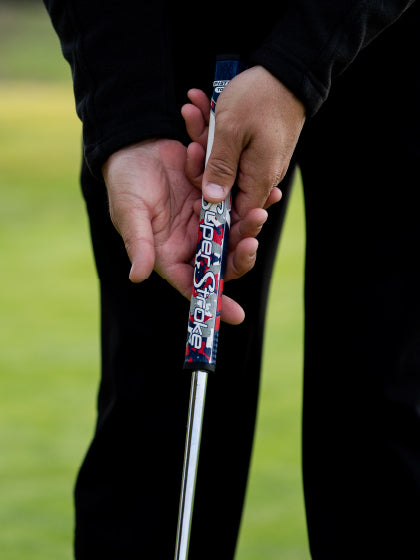The Masters Tournament proves it year after year: Fearsomely fast greens can frighten any golfer. When the game’s greatest need putting tips for handling extra-slick surfaces, many of them turn to SuperStroke ambassador Phil Kenyon.
We did the same, and we’ll share his advice with you in just a moment.
If you watched the 2021 Masters, you know just how difficult Augusta National’s greens can be. We saw putts come up inches short and others smashed several yards past. One poor soul actually putted off the 15th green into the water.
A couple of stats highlight the daunting nature of Augusta’s legendary greens:
- On golf courses hosting PGA Tour events, the average green slope (or grade) is 1.5 degrees. At Augusta National, it’s 2.5 degrees.
- PGA Tour pros 3-putt an average of .55 times per round. During the 2021 Masters, the average was nearly double (1.07 per round).
Most of us will never face greens as fast and undulating as Augusta’s. But you’re certain to feel out of your comfort zone every so often – especially if you travel for golf or play a lot of different courses.
Here’s where Phil Kenyon comes in.
Phil is, quite simply, a true expert on the artful science of putting. Based near Liverpool, England, he’s coached many of golf’s major winners including Rory McIroy, Brooks Koepka, Justin Rose, Henrik Stenson and Francesco Molinari.
Here are Kenyon’s top 5 putting for fast greens:
1. Play Plenty of Break
The faster the surface, the more a putt will break. Most golfers already know this.
Unfortunately, Kenyon observes, “Amateurs tend to pick a low line.” in other words, they play too little break. “Then they try to match their speed to that line and if they miss, the ball is miles away.”
When reading a quick, breaking putt, Kenyon recommends picking “the highest line you can see.” You’ll improve your chances of hole-ing it and, more importantly, decrease the odds of leaving a long come-backer.
2. Don’t Try to Strike the Ball on the Toe
There’s a decades-old debate about whether or not you should strike slippery downhillers toward the putter’s toe.
Proponents say this helps “deaden” impact so the golf ball doesn’t jump off the face.
Kenyon thinks it’s a bad idea.
“You’re just bringing another variable into play,” he says, noting that if you try to strike a spot other than the blade’s center – which your stroke is honed to hit – there’s no telling where you’ll make contact.
You may impart side-spin, too, sending the putt off line. Plus, toe-side contact often leads to a pushed putt as the face opens on impact.
3. Consider Using a Different Putter, Unless…
Conventional wisdom holds that using a lighter putter is advantageous on faster greens.
While Kenyon doesn’t discount the idea, he hasn’t seen any data confirming the theory.
He also notes that in today’s high-tech game, other changes are also possible. For instance, a putter with a soft insert might take some “heat” off impact. A putter with grooves or a milled face pattern could provide a similar benefit.
Ideally, Kenyon adds, you can simply use your regular putter – no switch needed. “If you can adapt easily to speed with the same club, you have fewer variables,” he says. “You just have to adjust the length of your putting stroke.”
4. Install a SuperStroke Golf Putting Grip
If you’re not already using one, that is.
Look no further than the PGA Tour – where the greens are always lightning fast and SuperStroke is the most popular grip – for validation.
What makes an oversized grip the best choice? It limits the amount of hand and wrist action, smoothing the putting stroke for more reliable control.
Kenyon puts it like this: “Small movements in and around the wrists cause big movements at the bottom of the golf club.”
And those big movements can mean unwanted pop at impact.
5. Use this Practice Drill
When the greens get super-slick, speed control is your No. 1 priority. A great way to groove this skill, Kenyon says, is to “create scenarios where you have to adapt, not just hitting every putt at the same pace.”
He suggests this drill:
- Take three golf balls and pick a spot about 5 feet from the hole; the putt can be straight or breaking.
- On the first putt, try to die the ball just over the front lip.
- On the second, roll it into the center of the hole.
- Your final putt should hit the back of the cup firmly.
Repeat the drill until you can hole all three putts at the correct entry speed, then move slightly farther away and start over.
A little practice can do wonders for your mechanics – and that’s the key to great putting, no matter how fast the greens get.




